History and major events of the Denver & Rio Grande Western
In the American tradition, a railroad is conceived by noble men for noble purposes: to develop a nation, or to connect small villages to the big city. The Denver & Rio Grande of 1870 was not that railroad. Much later, however, it came to serve an admirable public purpose, earn the appreciation of its shippers and passengers, and return a substantial profit.
The Rio Grande was conceived by former Union Brig. Gen. William Jackson Palmer. As surveyor of the Kansas Pacific (later in Union Pacific’s realm), Palmer saw the profit possibilities if you got there first and tied up the real estate. Palmer, apparently connecting dots on a map to appeal to British and Dutch investors, proposed the Denver & Rio Grande Railway to run south from Denver via El Paso, Texas, to Mexico City. There was no trade, nor prospect for such, between the two end points, but the proposal did attract sufficient capital to finish the first 75 miles to Colorado Springs in 1871.
Narrow-gauge origins
Palmer chose 3-foot gauge to save money, assessing that the real value lay in the real estate, not in railroad operation. At each new terminal, Palmer’s men corralled the land, then located the depot, profiting through a side company on land sales. Construction continued fitfully to Trinidad, Colo., 210 miles from Denver, by 1878. Above Trinidad, on the ascent to Raton Pass, Palmer’s engineers collided with the Santa Fe’s, who were building toward California. Realizing that a roundabout narrow-gauge competing with a point-to-point standard-gauge would serve neither the fare box nor the next prospectus, Palmer changed course, making D&RG a supply line to the gold and silver bonanzas blossoming all over Colorado and Utah. Thus the Rio Grande would look west, not south, and would plumb so many canyons in search of mineral wealth that it was a surprise to find one without its rails.
Turning west at Pueblo, Colo., and outfighting the Santa Fe for the Royal Gorge of the Arkansas River — where there truly was room for only one track — D&RG entered Leadville, Colorado’s first world-class mining bonanza, in 1880. Three years later, it completed a Denver–Salt Lake City main line west from Salida, Colo., via Marshall Pass and the Black Canyon of the Gunnison River. The last-spike ceremony in the desert west of Green River, Utah, was low-key, lest anyone closely examine this rough, circuitous, and glacially slow “transcontinental.” Almost as an afterthought, D&RG added a third, standard-gauge rail from Denver to Pueblo, acknowledgment that once paralleled by a standard-gauge competitor, narrow-gauge was a death sentence.
New owners, new purpose
Palmer then began to exit. The company went bust, twice, in rapid succession. The new investors repurposed the railroad again. Instead of transient gold and silver, the new salvation would be coal. Thick bituminous seams in the Walsenburg-Trinidad field fed beehive coke ovens of a new steel mill near Pueblo and heated much of eastern Colorado and western Kansas and Nebraska.
In Utah, coal seams 12-feet thick in the Book Cliffs and Wasatch Plateau fields, centered on the town of Helper, fed the copper, silver, and lead smelters, sugar factories, and homes of the Beehive State, eastern Nevada, and southern Idaho. Investment in the physical plant was miserly, made only when competition threatened. When the standard-gauge Colorado Midland started a shorter and faster route to Salt Lake, Rio Grande in 1890 standard-gauged its Pueblo–Salt Lake main line. This included a new route west of Salida that featured a lower-grade crossing of the Continental Divide in Tennessee Pass instead of the 4-percent grades of Marshall Pass on the original line between Salida and Montrose.
When the U.S. Smelting, Refining & Mining Co. tired of D&RG’s high rates and bad service, and proposed its own Utah Railway from its smelter near Provo to its coal mines south of Helper, Rio Grande during 1912 to 1914 reconstructed and double-tracked its main line across Soldier Summit, reducing the eastward grade from 4 percent to 2. D&RG also came to terms with Utah Railway, in 1913 reaching a joint agreement in which each carrier owned one main track from Utah Railway Junction (outside Helper) across Solider Summit to Provo.
World War I concluded with the Rio Grande broke and derelict. Its main line was ballasted mostly with native subgrade material. It had no block signals. Its locomotives, matched to the poor track and bad alignment, were mostly small-drivered 2-8-0s, buttressed by eight 2-6-6-2s and 16 slow compound 2-8-8-2s for helper service. Just 14 2-8-2 Mikados and six 4-6-2s of modest dimensions comprised the “modern” road fleet. The narrow-gauge gained 15 2-8-2s in 1903, but otherwise made do mostly with the 2-8-0s from its 1880 to 1883 expansion.
Part of the Gould empire
George Gould acquired control of the Rio Grande in his effort to build a coast-to-coast system. Bankrupt as a result of Gould’s using it to finance his Western Pacific, Rio Grande was reorganized in 1918 on unsustainable terms. Here the railroad could have come to an end. Its coal traffic was profitable, but those lines could operate as isolated feeders. No one needed the middle — most days, one or two through freights each way sufficed. The salvation, oddly, was the Interstate Commerce Commission and its regulation of minimum rates.
In 1924, the road was reorganized for the fourth time, as Denver & Rio Grande Western Railroad, controlled by Missouri Pacific and WP. The owners contemplated what to do with their third-rate transcontinental. Would the combination of minimum rates that UP and Santa Fe could not undercut; reconstruction enabling heavy, long, and faster freights; and competitive transcontinental passenger service, work?
The reconstruction was remarkable. The track from Pueblo to Malta, Colo., and Ruby Canyon to Helper was almost entirely realigned, eliminating loopiness where the narrow-gauge contractors had seemingly tried to move the fewest shovelfuls of dirt. New 85- to 110-lb. rail replaced the 60-lb. steel, and slag ballast replaced the native materials that left the track a slow-ordered morass each spring. Automatic block signals were installed from Pueblo to Salt Lake City, and in 1928, the second Centralized Traffic Control system in the U.S., on the single-track section of the 3-percent eastward grade between Deen and Tennessee Pass, was installed. To haul the bigger and faster trains, D&RGW acquired 20 simple 2-8-8-2s (at the time, the world’s heaviest locomotives), 30 heavy 4-8-2s, 10 heavier three-cylinder 4-8-2s, and 14 4-8-4s.
Even the narrow-gauge got its due. Heavier rail on Marshall Pass and Cumbres Pass supported 20 new 2-8-2s and 10 2-8-2s rebuilt from standard-gauge 2-8-0s, increasing train lengths and reducing operating costs.
Simultaneously, Rio Grande acquired control of the Denver & Salt Lake, a moribund but intriguing standard-gauge line running from Denver to a dead end at Craig, Colo., 230 miles to the west. It was built as the Denver, Northwestern & Pacific by mining promoter David H. Moffat. He undertook the “Moffat Road,” as it came to be known, in 1902 to, it was said, put Denver on a direct transcontinental route to Salt Lake City, albeit with an alignment hopelessly inferior to UP’s, and, with the exception of coal fields west of Phippsburg, bereft of on-line traffic. The coal was too far from Denver to effectively compete. Moffat failed to attract investors; as if actively writing his own obituary, he invested his entire fortune into his railway, then died in 1911. D&SL went bankrupt in 1912.
Joining with the Moffat Road
The Moffat Road was, however, at a point east of Glenwood Springs, a mere 38 water-level miles along the Colorado River from D&RGW’s main line. D&SL also had a 6.2-mile tunnel under the Continental Divide, bored with public dollars in 1928, on which D&SL paid a modest rent. This offered D&RGW a coup: buy the Moffat, build a connection, and, with ICC minimum rates in force, earn the same freight rate but at a big discount versus the extra 173 miles via Pueblo. Control of the Moffat Road, and construction of what became the Dotsero Cut-off (from “dot zero” to a point near Bond named Orestod — spell it backwards), were accomplished by 1934.
As for MoPac, its investment in the Rio Grande was for naught.
“They spent their way into bankruptcy, but there would have been no Rio Grande otherwise,” said James Ozment, a D&RGW Utah Division engineer.
The expenditure was poorly timed, and Rio Grande entered its fifth bankruptcy in 1935. Reorganized in 1947 and consolidated with D&SL, it had already become highly profitable thanks to World War II. Freight growth required 20 4-6-6-4s and five 4-8-4s, plus 15 secondhand 2-8-8-2s, two 2-6-6-2s, and four 4-8-2s from Norfolk & Western. At peak, the D&RGW had 10 2-10-2s, 43 4-8-2s, 19 4-8-4s, and 107 articulated locomotives, a staggering number of big locomotives for a small railroad. Moreover, virtually the entire main line via Moffat Tunnel was CTC-equipped by the end of World War II, years ahead of most western railroads.
This steam fleet was not enough — D&RGW was an early enthusiast for EMD’s FT, acquiring 14 four-unit sets during 1942 to 1944, plus 19 Alco S2 switchers. It later would sample many other models, including two three-unit PA sets and five RS3s from Alco, before settling on EMD F units as its mainline standard, augmented by GP and SD7s and 9s.
In 1949 Rio Grande began its most thrilling service: the Budd-built stainless-steel domeliner California Zephyr, a joint train with Burlington and WP that replaced the heavyweight Chicago–Oakland Exposition Flyer. With a route slower than UP’s or Santa Fe’s, the CZ competed on passenger experience. D&RGW also upgraded the Prospector, an overnight Denver–Salt Lake City train. Dome coaches built for Chesapeake & Ohio’s Chessie were acquired for the Royal Gorge, which ran on the original route via Pueblo.
Surprisingly, D&RGW also promoted its Durango–Silverton narrow-gauge, steam-powered service as a tourist draw. (Operated independently since 1981, it basically emulates tourist expeditions of a century ago.) But the narrow-gauge network was drawing to a close. The affiliated Rio Grande Southern northwest out of Durango, Colo., with 162 miles of astonishing scenery, was abandoned in 1951, the original main line via Marshall Pass by 1953, and the San Juan Extension from Alamosa to Durango and Farmington in 1968. The Antonito–Chama section, bought by the states of Colorado and New Mexico, runs as the Cumbres & Toltec Scenic Railroad.
Once again, a “coal road”
In the 1950s, coal traffic declined worryingly as users converted to natural gas, but metallurgical coal to the Colorado Fuel & Iron mill at Pueblo and to the big new U.S. Steel Geneva Works near Provo increased in volume. With electricity demand growing at 10 percent or more a year, soon utilities began asking for quotes on unit trains.
The steam coal boom gave D&RGW its greatest cash infusion ever. New 136-lb. welded rail, slag ballast, and hardwood ties became the sine qua non of the track structure. More than 3,000 100-ton hoppers became D&RGW’s pervasive “Great Steel Fleet,” a tongue-in-cheek nod to New York Central by photographer and former D&RGW officer Mel Patrick. New diesels arrived beginning in 1963, as 130 GP30s, 35s, and 40s replaced the Fs, and then through the 1970s as 26 SD45s and 73 SD40T-2s (with improved cooling performance in tunnels) arrived. Rio Grande’s locomotive fleet of 1980 had nearly three times the horsepower of 1960 — virtually all due to coal.
The California Zephyr, however, had only a pardon. WP wangled out of its portion in 1970, after which Burlington Northern and Rio Grande continued triweekly Chicago–Salt Lake service. In 1971 BN joined Amtrak, whose Zephyr ran on UP and SP west of Denver, but D&RGW stayed out to preserve dispatching flexibility on its slower, single-track line. Its triweekly Denver–Salt Lake train, renamed Rio Grande Zephyr, kept providing quality, daytime domeliner service until conveyed to Amtrak in 1983.
The Staggers Act of 1980 removed the rate umbrella that made Rio Grande’s transcontinental business profitable — indeed, possible. Bankruptcies and mergers began to close the gateways. At Denver, most D&RGW business had gone to Burlington Northern and the Rock Island, but the latter, bankrupt, was liquidated in 1980. To the west, the top partner remained Southern Pacific, which sent much of its lumber and canned goods east via D&RGW. Western Pacific accounted for one to two trains a day until UP merged it in 1982, at the same time removing Rio Grande’s principal connection at Pueblo by taking over the Missouri Pacific, although as a merger consequence D&RGW got trackage rights on MP to Kansas City, Kan.
In 1984, Rio Grande, mistakenly undervalued by Wall Street as was the entire railroad industry, was purchased by Philip Anschutz, a Denver investor who had built a fortune in oil and cement by recognizing value where others did not. In 1988, he bought Southern Pacific and combined the two under the SP name. When UP got SP in 1996, Rio Grande ceased to exist as a separate company. Since 1996, Tennessee Pass has been closed, and “home” traffic on the former D&RGW consists almost entirely of originating coal.
To look back at the Rio Grande’s history, one is struck by its ability to be many things, from promoter’s tool, to Lucius Beebe gold-rush icon, to transcontinental contender, to big-time coal road. With its snow-capped mountains, dark canyons, mining detritus, long black coal trains, domeliners, and narrow-gauge, the Rio Grande’s dial was always turned to “11.”
Perhaps nowhere else has so little trackage ever given so much to the richness of railroad history.





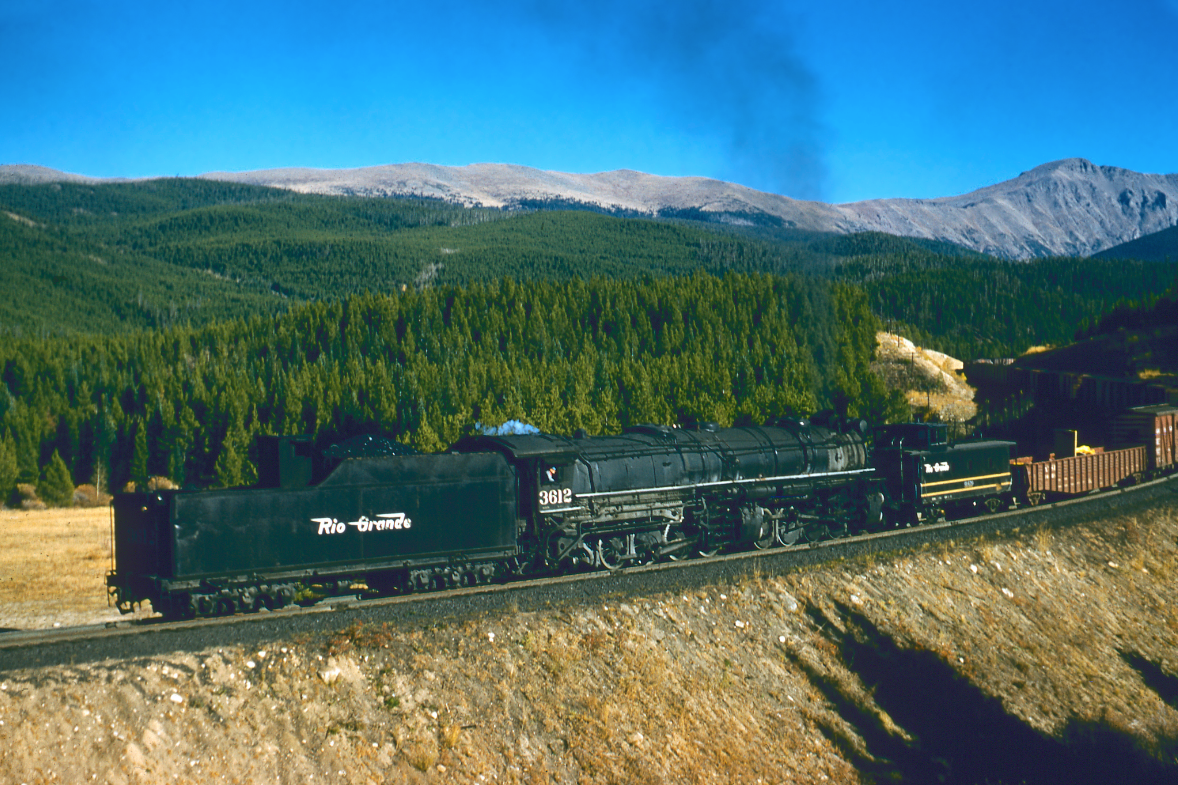
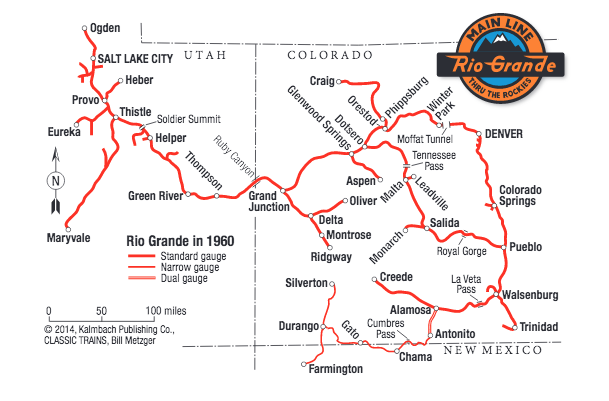
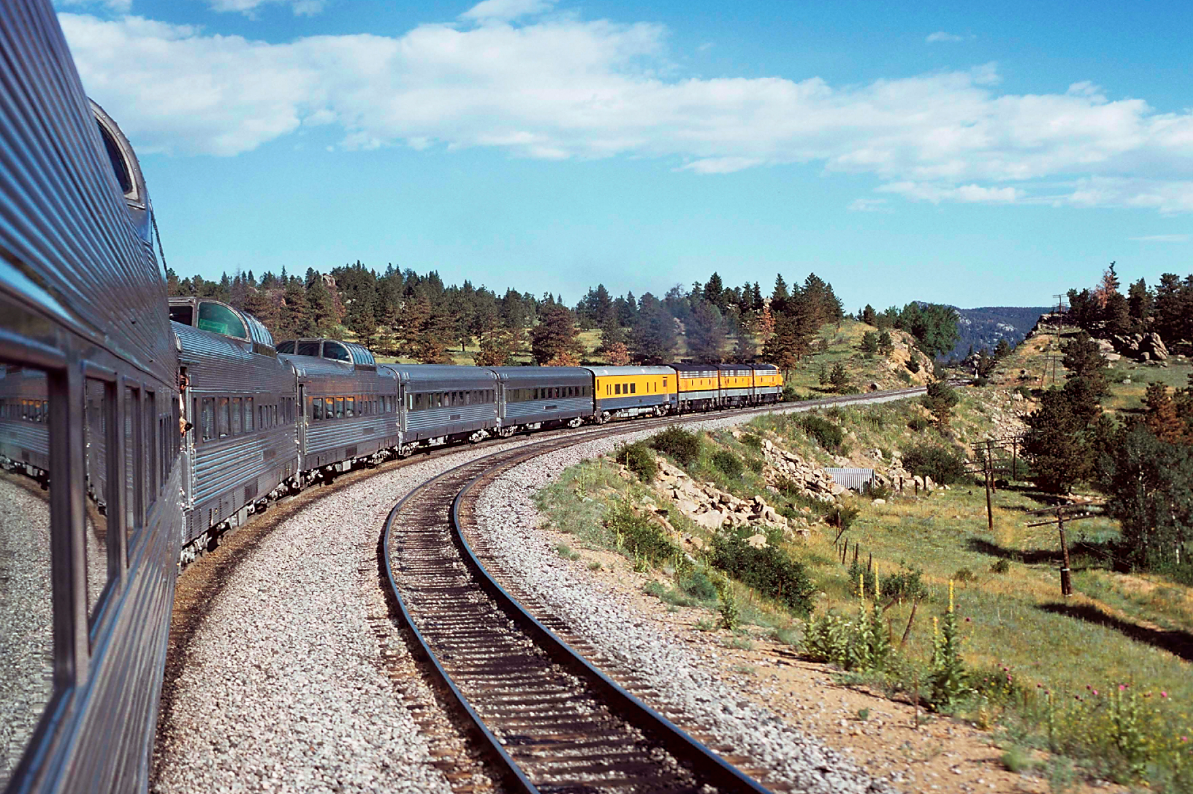
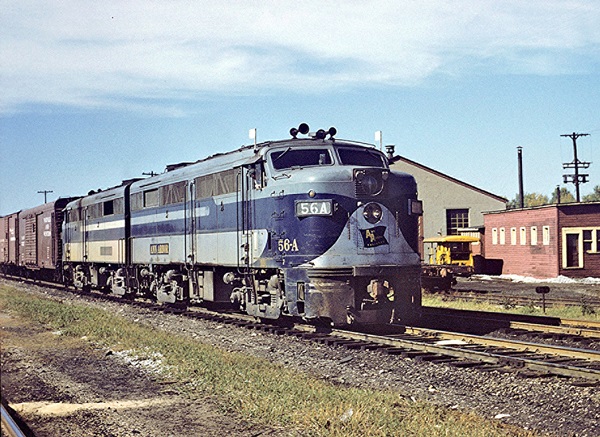



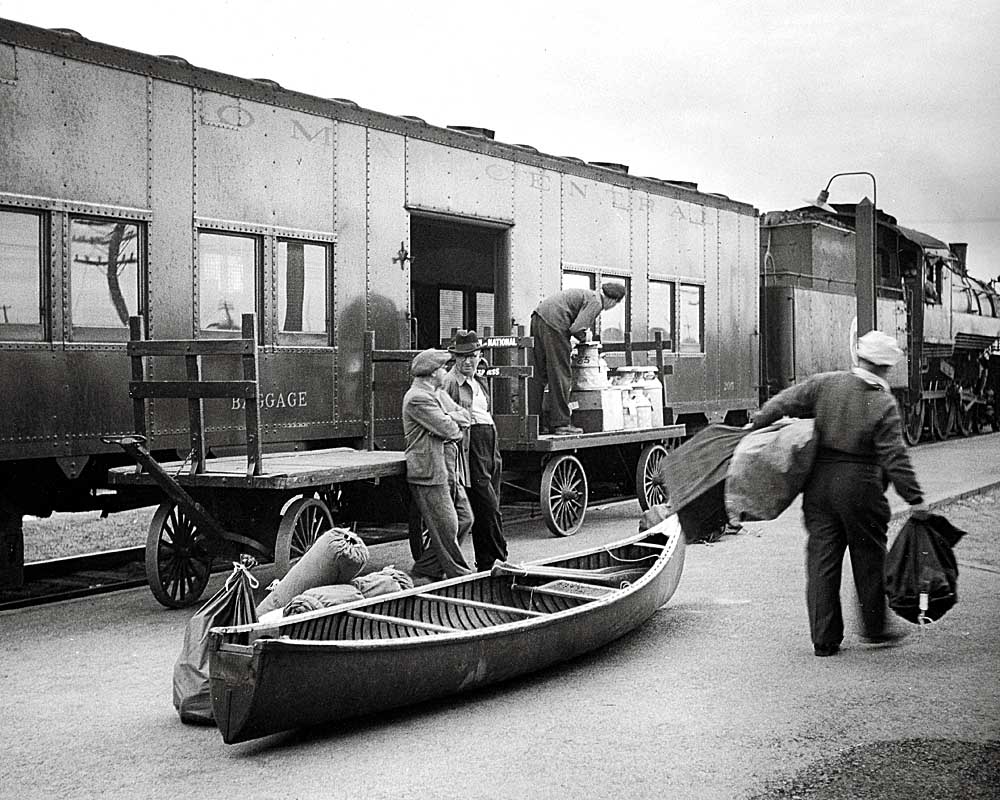





A technical error is listed in this Article. The author writes that DRGW put in Automatic Block System and this was the first Centralized Traffic Control system on mainline America. The error here is that ABS is not CTC.
ABS is traffic controlled by who gets at a control point first and time table/train order rules. CTC is a mother may I railroad, where traffic signals are controlled from a central location. Thus, they are not the same.
“A comment on Mark Hemphill’s D&RGW article: when Mark was the editor at TRAINS Magazine, he brought a level of beautiful prose and professional writing (and a demand for the same professional writing from contributors) to the publication that brought back whispers of David Morgan. Mark of course added in the hardness of tempered steel and the raw edge of blasted granite. And much different from Morgan, Mark is a child of the West, a Western railroader. That comes through in all his work, with the kind of punch-through writing that has made him one of the best railroad journalists in the country. Thank you, Mark.”
Mark still is a very active railroader and railfan, he just moved to Utah to help plan out and advocate for the Uintah Basin Railroad project. My friends who work in some of the local hobby shops always enjoy when Mark swings by to visit and talk about the Uintah Basin project; and its fun talking to him on Facebook.
It’s amazing that as beautiful as the Rio Grande Zephyr was in 1978, that it did enough business between two relatively small cities and a handful of other communities to have such a long consist. The tragedy is that the California Zephyr didn’t last on it’s original route until Amtrak. While the Superliner concept is generally good, it would be a smart model for Amtrak to create a new single level train with domes and on-board amenities for that route and a couple others that traverse scenic areas in daylight. Until the country commits to high speed rail (if ever), passenger trains need to find a different purpose than simply providing transportation.
Rode with their section on origlnal CZ and also when I rode Durango & Silverton in 1970, it was still owned by them. And I see my memory is correct as it says owned independently since 1981 so it still was theirs. We did not know if we would get that on our road trip around CO, so had no reservation. We got last room at Holiday Inn at 9 pm and they told us to get to station at 6 am and wait in line, station would open at 7 am and 2 trains running, so maybe they would have space. They did on second one and we were able to ride, would not happen today as I am sure they have reservations booked months in advance. Some other friends and I rode the C&T a couple of years ago. And I have ridden the Royal Gorge Route train too, D&RGW had some very scenic routes and I am glad they have been preserved.
(1) For John, there is a great “overview” book by Walter R. Borneman (“Iron Horses”) about the development of the Western railroads, and Walt details most of the Palmer/Sullivan Mexican connections. It is a great quick read, and a fantastic primer (or refresher) for anyone interested in the American West; (2) A comment on Mark Hemphill’s D&RGW article: when Mark was the editor at TRAINS Magazine, he brought a level of beautiful prose and professional writing (and a demand for the same professional writing from contributors) to the publication that brought back whispers of David Morgan. Mark of course added in the hardness of tempered steel and the raw edge of blasted granite. And much different from Morgan, Mark is a child of the West, a Western railroader. That comes through in all his work, with the kind of punch-through writing that has made him one of the best railroad journalists in the country. Thank you, Mark. Great to read you on a subject that you know so well. Steve Hites, Skagway, Alaska – St. Kitts, West Indies
I should note that this summer is the 50th anniversary of the States of New Mexico and Colorado purchasing the 64 miles of the Antonito to Chama portion of the San Juan Extension to become the Cumbres & Toltec Scenic Railroad. There will be big doin’s all spring and summer, both with the Railroad and the Friends of the Cumbres & Toltec, the all-volunteer restoration, preservation and interpretation “museum arm” of the Railroad.
The D&RGW has always been my favorite railroad and I count myself lucky to have ridden the Zephyr multiple times as well as the Royal Gorge and the Prospector. I miss them all.
Does anyone know of an article or book that tells more in detail about Gen Palmer’s foray into building a narrow gauge railroad with James Sullivan (The Palmer Sullivan Concession) in Mexico circa 1880, and the acquiring by Palmer of the Corpus Christi, San Diego & Rio Grande Narrow Gauge Railroad (partially built from Corpus Christi to near Laredo) and purchased and finished by Palmer in late 1880? Palmer renamed the CC, SD & RGNG RR the Texas Mexican Railway and it ran from the Gulf of Mexico at Corpus Christi, TX, to Laredo, where it joined Palmer’s narrow gauge rr at Nuevo Laredo which Palmer planned to build to Mexico City, but Palmer did not complete it.
If my memory is correct, and I think it’s based on a video, perhaps by Emery Gulash, the streamlined Prospector sometimes looked like a typical passenger train set: one of every type of car. Unusual and interesting!
Yes the California Zephyr was a great train and we have all seen a thousand photos of it.Not once have I seen a photo of the Prospector or even the Colorado Eagle.